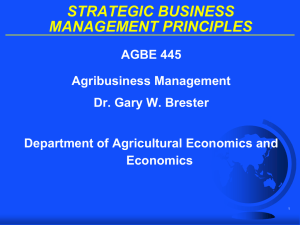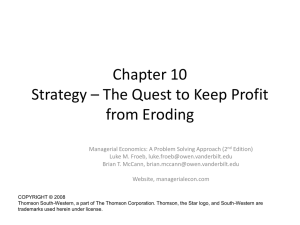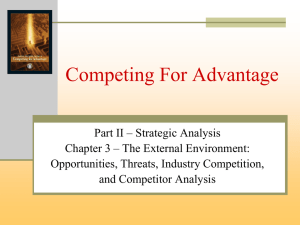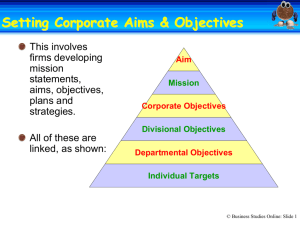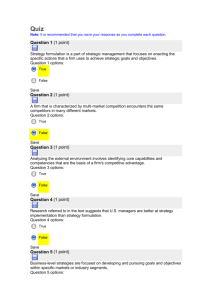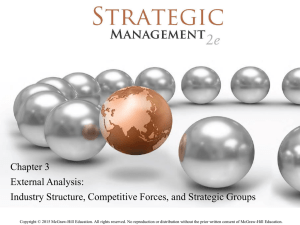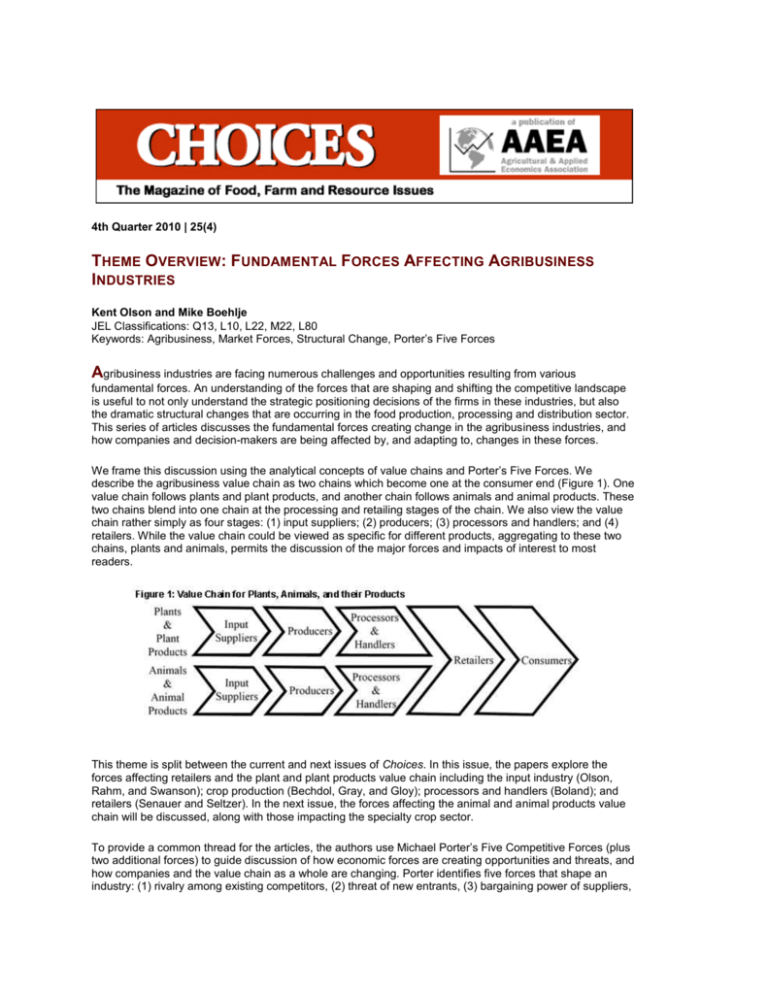
4th Quarter 2010 | 25(4)
THEME OVERVIEW: FUNDAMENTAL FORCES AFFECTING AGRIBUSINESS
INDUSTRIES
Kent Olson and Mike Boehlje
JEL Classifications: Q13, L10, L22, M22, L80
Keywords: Agribusiness, Market Forces, Structural Change, Porter’s Five Forces
Agribusiness industries are facing numerous challenges and opportunities resulting from various
fundamental forces. An understanding of the forces that are shaping and shifting the competitive landscape
is useful to not only understand the strategic positioning decisions of the firms in these industries, but also
the dramatic structural changes that are occurring in the food production, processing and distribution sector.
This series of articles discusses the fundamental forces creating change in the agribusiness industries, and
how companies and decision-makers are being affected by, and adapting to, changes in these forces.
We frame this discussion using the analytical concepts of value chains and Porter’s Five Forces. We
describe the agribusiness value chain as two chains which become one at the consumer end (Figure 1). One
value chain follows plants and plant products, and another chain follows animals and animal products. These
two chains blend into one chain at the processing and retailing stages of the chain. We also view the value
chain rather simply as four stages: (1) input suppliers; (2) producers; (3) processors and handlers; and (4)
retailers. While the value chain could be viewed as specific for different products, aggregating to these two
chains, plants and animals, permits the discussion of the major forces and impacts of interest to most
readers.
This theme is split between the current and next issues of Choices. In this issue, the papers explore the
forces affecting retailers and the plant and plant products value chain including the input industry (Olson,
Rahm, and Swanson); crop production (Bechdol, Gray, and Gloy); processors and handlers (Boland); and
retailers (Senauer and Seltzer). In the next issue, the forces affecting the animal and animal products value
chain will be discussed, along with those impacting the specialty crop sector.
To provide a common thread for the articles, the authors use Michael Porter’s Five Competitive Forces (plus
two additional forces) to guide discussion of how economic forces are creating opportunities and threats, and
how companies and the value chain as a whole are changing. Porter identifies five forces that shape an
industry: (1) rivalry among existing competitors, (2) threat of new entrants, (3) bargaining power of suppliers,
(4) bargaining power of buyers, and (5) the threat of substitute products (Porter, 2008). Two additional forces
affecting competition have been described as: (6) technology and (7) other drivers of change (Boehlje and
Hofing, 2005). These last two forces introduce an external dynamic to Porter’s forces. These seven forces
are described briefly below.
Rivalry among Established Firms
The level of rivalry within an industry can depend, in large part, on the number of firms, demand conditions,
and exit barriers. Due to the number of firms involved, many agricultural industries are often described as
perfectly competitive—as opposed to monopolistic competition, oligopoly, or monopoly. However,
government regulation and intervention, as well as the size and dominance of a few firms, can provide
different degrees of perfect competition.
Rivalry also varies depending on whether demand is growing with new customers, growing with existing
customers, stagnant, or declining. With growing demand and new customers, firms can find customers more
easily and expand production. With only existing customers, firms will have to compete more on price and
nonprice factors to capture customers from competitors and keep current customers. Rivalry is greatest when
demand is declining as firms vie for a share of a shrinking market.
Higher exit barriers can increase rivalry and competitive pressures. This can happen when profitability is low
for an industry, but firms are unable to exit—or exit quickly—due to investments in specialized assets, high
exit/shut-down costs, emotional attachments to an industry, or contractual or other relationships between
firms.
Threat of Entry by Potential Competitors
Potential competitors may be across the road, across the nation or across the ocean. The threat of entry
depends on the height of barriers to entry. These barriers include: the extent to which established firms have
scale economies, the extent to which established firms enjoy a market or cost advantage over potential
entrants, high capital requirements for new entrants, the extent to which established firms have better access
to distribution channels for inputs and outputs, the extent to which government regulations restrict entry, and
the extent to which established firms have brand name loyalty with customers.
Bargaining Power of Suppliers
Suppliers are a threat to firm and industry profitability when they are able to increase the price of their
product or affect the quantity and quality of the products supplied. Fewer suppliers mean they have greater
power. Improved communication technology has taken away the power of many local suppliers. The recent
mergers of suppliers and the consolidation of input technologies, such as seeds and pesticides, have
increased the suppliers’ bargaining power with farmer-customers, as well as changed the competitive
pressures within the input industries. Suppliers have power if they are more concentrated than their buyers,
do not receive a high percentage of their revenues from one industry, have customers with high switching
costs to change suppliers, have a differentiated product, have a product with no substitutes, through either
real differences or patent protection, or could forward integrate into additional stages in the value chain.
Bargaining Power of Buyers
The number of buyers has a very large impact on how the market works. Fewer buyers mean they have
greater power. If sellers cannot easily ship their products to other markets, or they do not have price
information from other markets, a few local buyers can have considerable power even though the total
number of buyers is large in the broader market. The increasing use of contracts can increase the power of
the buyer through controlling the amount of price information in the marketplace. In ways similar to suppliers,
buyers have power if they are few in number or a few buy a large percentage of the product in the market,
products are undifferentiated commodities, or buyers could integrate backwards in the value chain. Buyers
will also bargain harder if the product constitutes a major portion of the buyer’s total costs, or if the product
has little effect on the quality of the buyer’s product or other costs.
Substitute Products and Services
Substitute products limit the price that producers can seek or ask for without losing customers to those
substitutes. Competitive pressure comes from the attempts of the producers of the substitutes to win buyers
to their products. The advertising campaigns of the pork, beef, and poultry industries are an obvious example
of the competitive pressures due to substitute animal protein products; each industry feels forced to advertise
to keep customers, and cannot charge as much as they would like without pushing their customers into
buying other products.
Technology
Changes in technology can have a large impact on the production of and demand for a service or product of
a firm. The risk from technological change depends on the size and the role of technology in the industry, as
well as the speed of technical change. Advances in technology can be disruptive; they can cause leaps that
leave users of old technology far behind. The expected lifespan or change in technology can put businesses
on the treadmill of continually having to retool to keep up with their competitors. New technology can alter not
only the efficiency and cost of the production process, but the actual products and services offered and
demanded by others in the value chain. New chains may be created due to a new technology in
communication as well as in products and services.
Other Drivers of Change
Other drivers of change include changes in government policy and regulations, changes in international trade
agreements, demographic changes, and other factors not included in the first six forces. Competitive
pressure comes from differing abilities of firms to respond and adapt to these changes. The impact of these
forces depends on the scope of the change, the speed at which change is anticipated or actually felt, and the
depth and breadth of the responses needed to adapt to these changes.
Figure 2 provides a pictorial summary of the modified Five Forces framework. This framework was used by
each of the authors of the articles for this theme to analyze the challenges, opportunities and changes for the
various stages of the agribusiness value chain.
For More Information
Boehlje, M., and Hofing S. (2005). Managing and Monitoring a Growing Production Agriculture Firm: Part II.
Centrec Consulting Group, LLC., Savoy, Illinois, available online:
http://www.centrec.com/resources/pres/2005%20presentation.pdf.
Porter, Michael E. (2008). The Five Competitive Forces that Shape Strategy. Harvard Business Review.
(January 2008), p. 79-93.
Kent D. Olson (kdolson@umn.edu) is Professor, Department of Applied Economics, University of Minnesota,
St. Paul, Minnesota. Michael Boehlje (boehljem@purdue.edu) is Distinguished Professor, Department of
Agricultural Economics, Purdue University, West Lafayette, Indiana.
© 1999-2010 Choices. All rights reserved. Articles may be reproduced or electronically distributed as long as
attribution to Choices and the Agricultural & Applied Economics Association is maintained.





